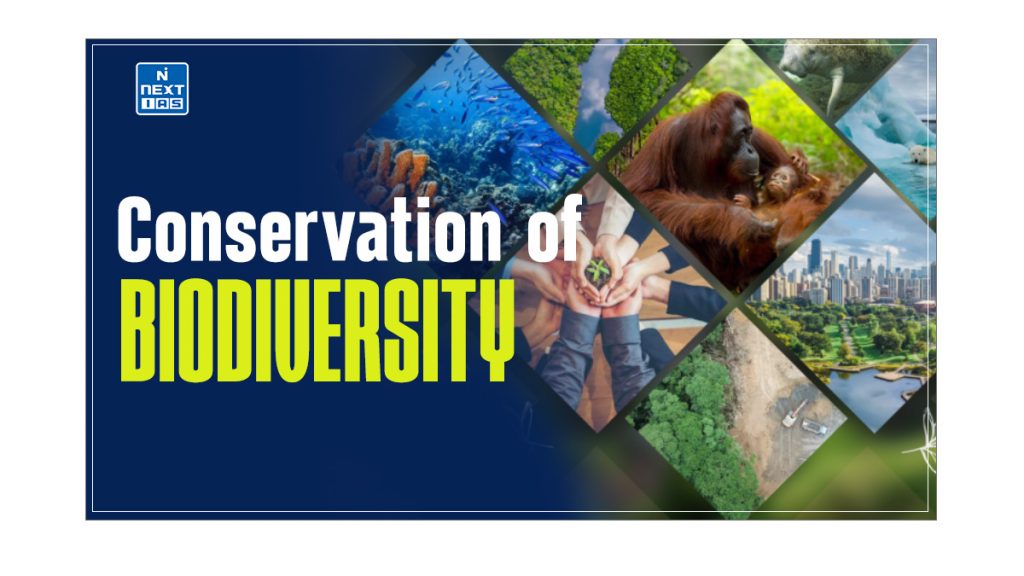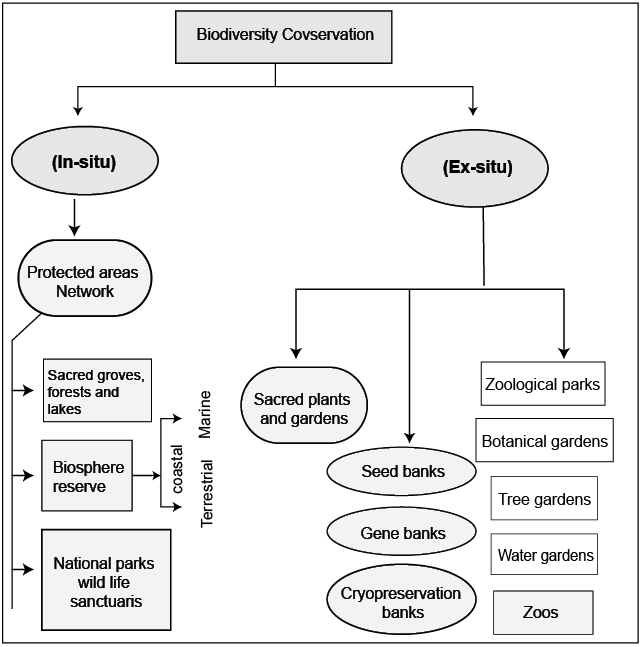
Conservation of Biodiversity or Biodiversity Conservation is crucial for tackling biodiversity loss and the threats posed by it. A comprehensive strategy for conserving and protecting biodiversity is essential for ensuring the well-being of humans as well as the planet. This article aims to study in detail the concept of Conservation of Biodiversity, its meaning, needs, types, challenges and other related concepts.
What is Biodiversity Conservation?
- Biodiversity Conservation refers to the protection, preservation, management, or restoration of wildlife and their natural habitats, such as forests and water.
- The survival of many species and habitats that are threatened due to human activities can be ensured by conserving biodiversity.
Need for Conservation of Biodiversity
Biodiversity is crucial for maintaining the stability of the ecosystems. For example:
- Rainforests, contribute both to the process of soil formation and help to regulate the climate through photosynthesis by producing oxygen and absorbing carbon dioxide.
- Wetlands act as sponge-like reservoirs in dry weather and help to filter and purify water.
- Coral reefs and mangrove swamps protect the land that they surround by reducing the effects of erosion and also acts as first line of defence during disaster like Tsunamis, Storm surge etc.
Biodiversity loss can lead to the destruction of ecosystems, which, in turn, can have a catastrophic effect both on local and global levels.
What is Biodiversity Loss?
- Biodiversity Loss refers to the decline or disappearance of biological diversity within a species, ecosystem, geographic area, or on the entire planet.
- In other words, it’s essentially a reduction in the variety of life on Earth.
- For example, at one point in the past, Dinosaurs thrived on the Earth, but today, there are no Dinosaurs left on the planet.
- There are various causes of Biodiversity Loss, and most of them emanate from the actions of human beings.
- Biodiversity loss has adverse impacts on our environment and societies.
Read our detailed article on Biodiversity Loss, Its Causes & Consequences.
Biodiversity Conservation Methods
Broadly, there are two methods of Biodiversity Conservation: In-Situ Conservation and Ex-Situ Conservation.

In-Situ Conservation Methods
- In-situ conservation of biodiversity involves the conservation strategies to be followed in the habitat of the concerned species’ ecosystem.
- It can either be targeted at populations of selected species (species-centered) or whole (ecosystem-based).
Read our detailed article on In-Situ Conservation.
Ex-Situ Conservation Methods
- Ex-situ conservation of biodiversity refers to the preservation of species by relocating them from their natural habitats to a controlled environment.
- The primary objective of ex-situ conservation is to ensure the survival of species, facilitate research, and potentially reintroduce species into their natural habitats once conditions improve.
- This approach is often employed when species are critically endangered or when their habitats are severely degraded.
- Some of the prominent methods of ex-situ conservation include:
- Botanical Gardens
- Zoological Parks
- Gene Banks
- Seed Banks, and
- Cryopreservation
Read our detailed article on Ex-Situ Conservation.
Challenges in Conservation of Biodiversity
- The rising human population inevitably results in human-animal conflict caused by fragmentation and destruction of habitats.
- Prevalent socio-economic inequality results in the unsustainable harvesting of biological resources by the wealthy sections of society, violating the basic access rights of the poor.
- Lack of capital & technology with the poor and developing countries, which are often the hotspots of biodiversity.
- Difficulty in determining the economic value of biodiversity often results in it getting less importance in high-level policy-making.
Conclusion
Conservation of Biodiversity is paramount for sustaining life on Earth, maintaining ecosystem services, and supporting human well-being. The rapid loss of biodiversity calls for urgent and concerted efforts to protect and restore natural habitats, implement sustainable practices, and engage communities in biodiversity conservation initiatives. By valuing and preserving biodiversity, we can ensure a thriving and resilient planet for future generations.
Frequently Asked Questions (FAQs)
How can we conserve biodiversity?
Biodiversity conservation requires use of various ex-situ and in-situ methods to protect and manag the variety of life on Earth, including plants, animals, fungi, and microorganisms.
What is the main aim of conservation of biodiversity?
The main aim of biodiversity conservation is to maintain and protect the variety of life on Earth in order to ensure the health and stability of the natural world and to support human well-being.
GS - 3





